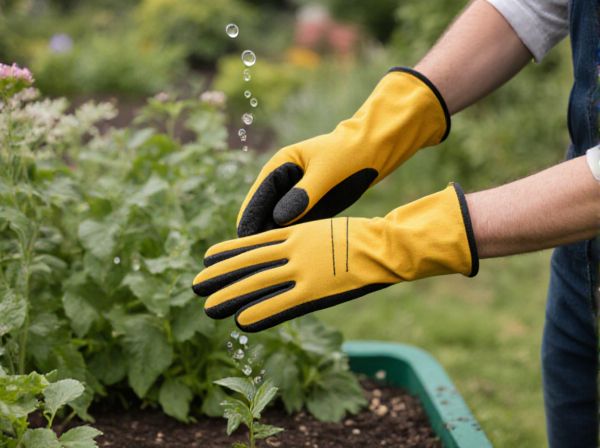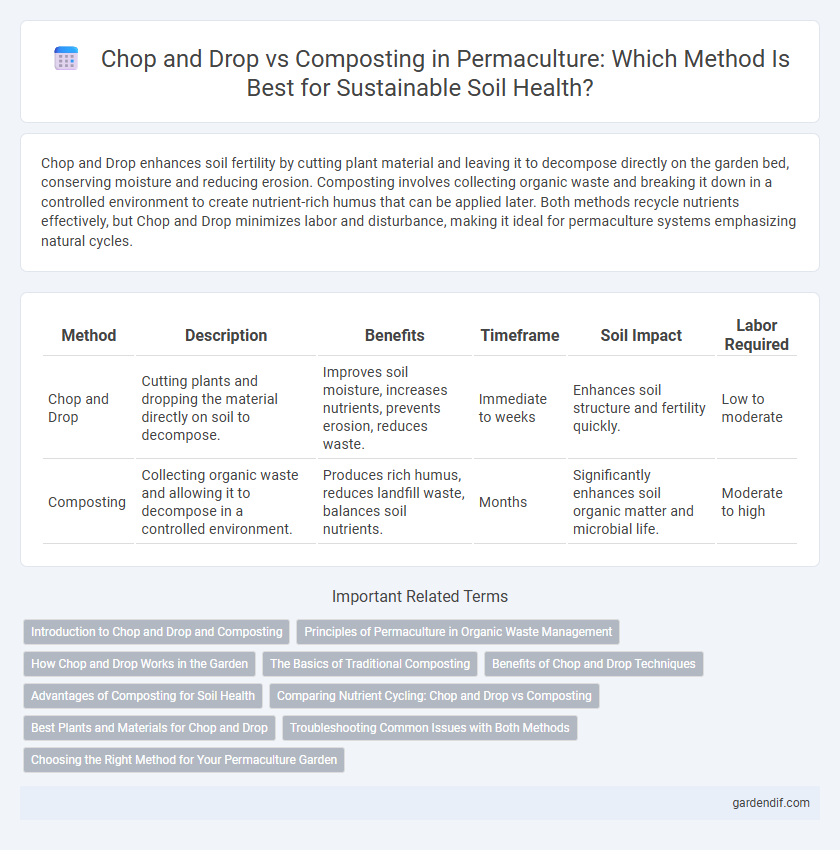
Chop and Drop vs Composting Illustration
Chop and Drop enhances soil fertility by cutting plant material and leaving it to decompose directly on the garden bed, conserving moisture and reducing erosion. Composting involves collecting organic waste and breaking it down in a controlled environment to create nutrient-rich humus that can be applied later. Both methods recycle nutrients effectively, but Chop and Drop minimizes labor and disturbance, making it ideal for permaculture systems emphasizing natural cycles.
Table of Comparison
| Method | Description | Benefits | Timeframe | Soil Impact | Labor Required |
|---|---|---|---|---|---|
| Chop and Drop | Cutting plants and dropping the material directly on soil to decompose. | Improves soil moisture, increases nutrients, prevents erosion, reduces waste. | Immediate to weeks | Enhances soil structure and fertility quickly. | Low to moderate |
| Composting | Collecting organic waste and allowing it to decompose in a controlled environment. | Produces rich humus, reduces landfill waste, balances soil nutrients. | Months | Significantly enhances soil organic matter and microbial life. | Moderate to high |
Introduction to Chop and Drop and Composting
Chop and drop is a permaculture technique where plant material is cut and left to decompose on the soil surface, enhancing moisture retention and nutrient cycling directly at the site. Composting involves collecting organic waste in a controlled environment to break down into nutrient-rich humus, which is later applied to the garden to improve soil fertility. Both methods support sustainable soil management but differ in process timing and nutrient release rates.
Principles of Permaculture in Organic Waste Management
Chop and drop aligns with permaculture principles by closing nutrient loops directly on-site, enhancing soil structure, and reducing waste through mulching organic residues. Composting, while enriching soil fertility by breaking down organic matter externally, requires additional labor and space but enables controlled decomposition and pathogen elimination. Both methods support soil health and biodiversity, integral to sustainable organic waste management in permaculture systems.
How Chop and Drop Works in the Garden
Chop and drop involves cutting plant material and leaving it on the soil surface to decompose naturally, enriching the garden with organic matter and nutrients. This method minimizes labor by eliminating the need to transport and manage compost piles while enhancing soil moisture retention and microbial activity. By recycling plant residues in situ, chop and drop supports sustainable soil fertility and reduces waste in permaculture gardens.
The Basics of Traditional Composting
Traditional composting involves collecting organic waste such as kitchen scraps, garden clippings, and leaves, then layering these materials to balance carbon-rich "browns" and nitrogen-rich "greens." This process requires regular turning to aerate the pile, promoting microbial activity that breaks down organic matter into nutrient-rich humus. Unlike the chop and drop method, composting consolidates waste into a concentrated pile, accelerating decomposition and producing a soil amendment that improves soil structure and fertility.
Benefits of Chop and Drop Techniques
Chop and drop techniques enhance soil fertility by directly returning nutrients to the garden bed, reducing the need for external fertilizers. This method promotes moisture retention and suppresses weed growth, creating a healthier growth environment for plants. By minimizing waste and labor, chop and drop supports sustainable permaculture practices and boosts overall ecosystem resilience.
Advantages of Composting for Soil Health
Composting enriches soil by breaking down organic matter into nutrient-rich humus that enhances soil structure and water retention. This process boosts microbial diversity, promoting a healthy ecosystem that supports plant growth and disease resistance. Unlike chop and drop, composting allows for better management of nutrient release timing, ensuring sustained nourishment for crops over extended periods.
Comparing Nutrient Cycling: Chop and Drop vs Composting
Chop and drop accelerates nutrient cycling by directly returning organic matter to the soil surface, enhancing microbial activity and moisture retention, whereas composting involves a controlled decomposition process that produces stabilized humus rich in nutrients. Chop and drop provides immediate nutrient availability and supports soil structure through root systems and mycorrhizal networks, while composting can take weeks to months but results in a concentrated nutrient source beneficial for varying soil types. Both methods improve soil fertility, but chop and drop integrates nutrients faster into the ecosystem, promoting continuous plant growth, while compost offers a balanced, long-term soil amendment.
Best Plants and Materials for Chop and Drop
Best plants for chop and drop include dynamic accumulators like comfrey, nitrogen-fixing legumes such as clover and vetch, and fast-growing cover crops like ryegrass. Woody prunings from shrubs and trees, green leafy materials rich in nitrogen, and pest-repellent herbs like rosemary and basil enhance soil fertility and structure when left to decompose in place. Materials with diverse textures and nutrient profiles accelerate microbial activity, improve moisture retention, and reduce erosion in permaculture systems.
Troubleshooting Common Issues with Both Methods
Chop and drop may lead to uneven mulch layers, causing slower decomposition and potential pest attraction, while composting often faces challenges like improper moisture levels that hinder microbial activity. Address these issues by regularly monitoring mulch thickness and pest presence in chop and drop zones, and by maintaining balanced carbon-to-nitrogen ratios and adequate aeration in compost piles. Optimizing these key factors enhances nutrient cycling efficiency and supports healthier soil ecosystems in permaculture systems.
Choosing the Right Method for Your Permaculture Garden
Chop and drop accelerates nutrient cycling by directly returning organic matter to the soil surface, enhancing microbial activity and moisture retention crucial for permaculture gardens. Composting, while time-intensive, produces nutrient-rich humus ideal for enriching garden beds and improving soil structure. Selecting between these methods depends on your garden's immediate nutrient needs, space availability, and desired labor intensity to optimize soil health and plant growth.
Chop and Drop vs Composting Infographic

 gardendif.com
gardendif.com